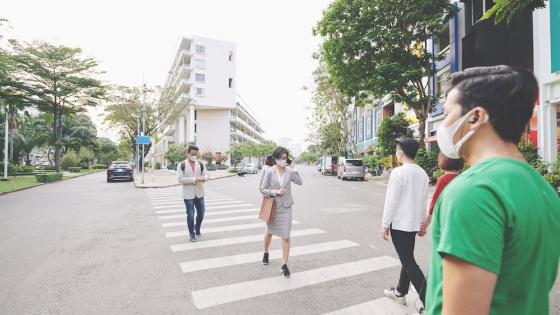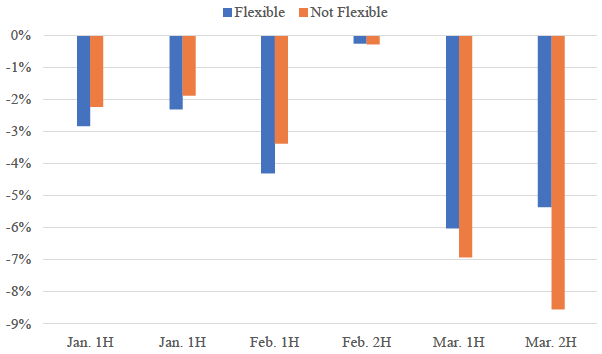There is no doubt that the COVID-19 crisis will affect the whole of Japan and significantly contract economic activities. The labour market is no exception. But the effects are hardly uniform across heterogenous groups of workers, and careful analysis is needed to identify who are the most vulnerable, the most severely hurt by the crisis, and the most in need of immediate assistance.
In this column, we use the Employment Status Survey (ESS), which provides detailed information about individual workers’ age, gender, occupation, industry, and employment type, to identify those most susceptible to COVID-19 shocks. We also use consumption data from the JCB Consumption NOW, which has expenditure data on one million active credit card members during the initial weeks of the pandemic, and assess the preliminary effects on different groups of workers.
Heterogeneous vulnerability
In Kikuchi et al. (2020), we follow Kaplan et al. (2020) and divide jobs into two dimensions: first, by industries (‘social’ and ‘ordinary’), according to the degree of social and face-to-face elements; and second, by occupations (‘flexible’ and ‘non-flexible’), based on the flexibility of the work location and possibility of completing tasks remotely (most likely from home).
The most vulnerable populations in terms of occupation and industry are those engaged in social and flexible jobs. As shown in Table 1, this group earns the least and constitutes about a quarter of the labour force in Japan.
Table 1 Employment share (%, upper) and average earnings (in JPY1,000, lower) by sector and occupation
Vulnerability by employment type, gender, and education
As documented in Kitao and Mikoshiba (2020), the Japanese labour market is characterised by a peculiar distinction in employment types, and consists of a combination of regular (seiki) and contingent (hiseiki) workers. Workers in the latter group are more prone to displacement, especially when the economy falls into a recession. See Yokoyama et al. (2019) for empirical analysis on the pattern of employment adjustment.
Table 2 shows that contingent workers are significantly more vulnerable to COVID-19 shocks than regular workers. The share of the most vulnerable group – those in social and non-flexible jobs – constitute 44% of contingent workers, while the share is about 17% among regular workers. Moreover, the levels of earnings are significantly lower among contingent workers in all four cells.
Table 2 Employment share (%, upper) and average earnings (in JPY1,000, lower) by employment type
Vulnerability differs in other dimensions as well. Women are more vulnerable to COVID-19 shocks than men, and low-skilled workers are more vulnerable than highly-skilled workers, as shown in Tables 3 and 4. Moreover, the more vulnerable earn less in both dimensions. The data suggests that the COVID-19 shocks will hit groups of lower-income individuals harder and considerably worsen inequality.
Table 3 Employment share (%, upper) and average earnings (in JPY1,000, lower) by gender
Table 4 Employment share (%, upper) and average earnings (in JPY1,000, lower) by education
Expenditure data during the COVID-19 crisis
We use expenditure data from JCB Consumption NOW during the initial weeks of the pandemic and provide a preliminary assessment of the effects of the COVID-19 shocks on different sectors. We allocate expenditures on different goods and services into industries based on the type of items purchased, retail and wholesale margins of the type, and original manufacturers. We then use the distribution of worker types (ordinary versus social, flexible and non-flexible) in a subdivided industry computed with the ESS data to derive effects on each sector.
Our analysis indicates a larger decline in economic activities in the social sector than the ordinary sector, and in the non-flexible sector than the flexible sector, especially in March, as shown in Figures 1 and 2.1
Figure 1 Change in expenditure: Ordinary versus social (% change, year-on-year)
Figure 2 Change in expenditure: Flexible vs non-flexible (% change, year-on-year)
Assuming that the decline in earnings would follow the impact on sectors, we simulate changes in earnings of heterogeneous groups of individuals due to the COVID-19 crisis. We find that the crisis will hurt vulnerable groups more: it affects women more negatively than men, on average; the low-skilled more than the highly-skilled; and contingent workers more than regular workers. Investigating heterogeneous impacts across workers reveals that the COVID-19 crisis has already begun exacerbating inequality in many dimensions of worker heterogeneity.
Summary
Our findings suggest that the COVID-19 crisis will not only destroy economic activity at the aggregate level, but at an individual level as well, through rising inequality and more pronounced shocks falling on low-income groups. Our analysis indicates the need for the government to respond immediately and provide financial support to those groups who are more vulnerable to being severely hit by the crisis. It is critical that the government continues to closely monitor changing labour market data to identify affected individuals, and pays close attention to their financial conditions to mitigate economic distress at an individual level.
References
Baldwin, R and B Weder di Mauro (2020), "Economics in the time of COVID-19: A new eBook", VoxEU.org, 6 March.
Kaplan, G, B Moll and G Violante (2020), “Pandemics according to HANK”, working paper.
Kikuchi, S, S Kitao and M Mikoshiba (2020), “Heterogeneous Vulnerability to the COVID-19 Crisis and Implications for Inequality in Japan”, RIETI Discussion Paper.
Kitao, S and M Mikoshiba (2020), “Females, the elderly and also males: Demographic aging and macroeconomy in Japan”, Journal of the Japanese and International Economies 56: 101064.
Yokoyama, I, K Higa and D Kawaguchi (2019), “Adjustments of regular and nonregular workers to exogenous shocks: Evidence from exchange-rate fluctuation”, Industrial and Labor Relations Review, forthcoming.
Endnotes
1 Figure 1 and Figure 2 are based on JCB Consumption NOW, Economic Census for Business Activity of METI and MIC, showing changes in credit card expenditure in each sector compared to the same period of the previous year. Ordinary sector consists of E-Commerce, Production, Transmission and Distribution of Electricity, Communication, and Online content delivery. Social sector consists of Eating out, Travel, Medical care, Transportation, Entertainment, and Accommodation. For flexible vs non-flexible, we use the Survey of Remote Work Implementations by the Ministry of Land, Infrastructure and Transport and define an occupation as flexible (F) if more than 20% of workers within the occupation are able to work remotely and as non-flexible (N) otherwise. For retail sectors, we allocate total expenditures into retail and wholesale industries of sold goods and services, based on retail and wholesale margins of each sector (Economic Census for Business Activity), and allocate the rest to either the manufacturing or agriculture industries.
Figures are based on nominal expenditures. CPI growth is 0.7, 0.4 and 0.4 (year-on-year %, MIC) in January, February, and March 2020, respectively, and is not taken into account in the calculation.













